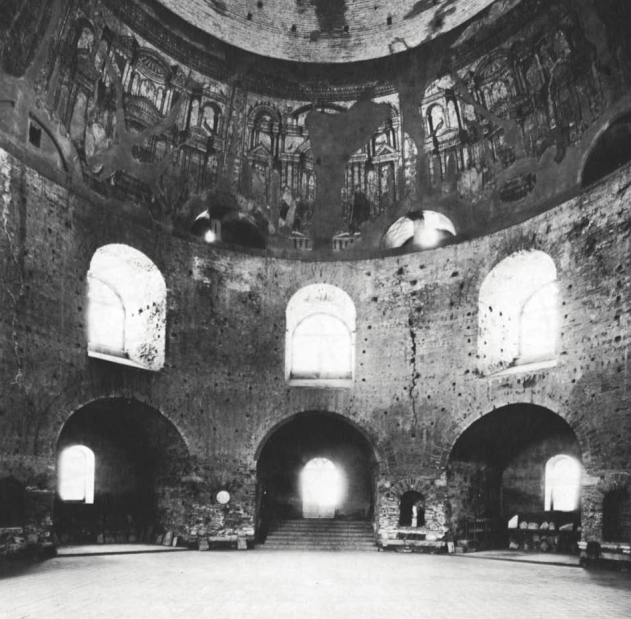Rotunda of Galerius (Church of St. George). Thessalonike, about 298/299(?)-311 and later
The rotunda stood within a precinct wall as the northern focus of a monumental ensemble near the eastern ramparts of Thessalonike that included the Arch of Galerius, an imperial residence, and a hippodrome. Construction of this ensemble may have been begun by the Caesar Galerius as early as about 298-299 and probably no later than about 305-306, when Galerius was elevated to Augustus.
The association of a monumental rotunda with a palace-hippodrome complex is paralleled in other Tetrarchic and Constantinian ensembles (no. 100). The rotunda was probably intended to serve as an imperial mausoleum, although most ancient mausolea were located outside the city walls.

Later, the rotunda was transformed into a church by the addition of a continuous ambulatory, a deep chancel and apse to the east, and to the south, a narthex flanked by staircase towers. Dygg-ve (1958) and Torp (1963) have attributed this conversion to about 390, but this date has been challenged on various grounds by Vickers (1973) and Kleinbauer ([1], 1972), who attribute the conversion to about 450. The original dedication and precise function as a church remain in doubt.
The rotunda was a freestanding version of such imperial structures as the caldarium of the Baths of Caracalla in Rome. It is constructed of alternating brick bands and courses of mortared rubblework. The materials and technique of construction have affinities with buildings of the third century in the northern Aegean and in western Asia Minor. The perimeter wall of the rotunda is pierced by eight large, radiating, barrel-vaulted recesses, and, above them, eight similar, smaller recesses containing large windows. The building is also lit by semicircular lunettes in the dome just above the springing. The interior was capped by a dome constructed in an unusual manner: the lower part of the dome is based on a hemisphere centered on the level of the springing line, while the upper part follows a steeper curvature, based on a center about 6± feet higher. Boethius and Ward-Perkins (1970, pp. 522 ff.) believe that the dome design is Galerian and was employed by the builders to reduce the effective span from 79 to 62 feet, corbeling the lower part inward without scaffolding and making the pitch of the crown less dangerously shallow. Torp (1963), who observes that the bricks in the upper part of the dome date from the time of the structure's conversion, supposes that the original crown of the dome either contained an oculus, as in the Pantheon in Rome, or collapsed and that the break in the curvature points toward two different building periods, Galerian (about 300) and Theo- dosian (about 390).
The lavish interior decoration consisted of marble revetment arranged with two orders of pilasters and entablatures framing the eight recesses and, on the piers between the ground- floor recesses, eight small aediculae, as in the buildings of Diocletian and Maxentius in Rome. Whether this decoration dates to the Galerian period or to the period of the conversion of the building remains unresolved. All the surviving mosaics (no. 491) date from either about 390 or about 450. Bibliography: Hebrard, 1920; Dyggve, 1958; Torp, 1963, pp. 1-11; Kleinbauer (1), 1972; Kleinbauer (2), 1972; Vickers, 1973.
Date added: 2025-08-01; views: 154;
